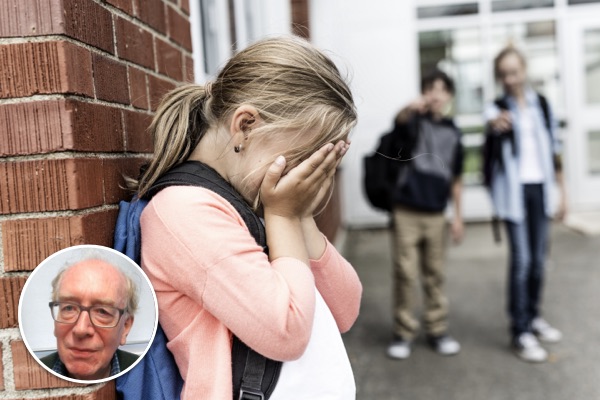The Link Between Mental Health and Behaviour
by Helen Spiers on Jul 10, 2023

This month has seen the publication of the Children and Young People’s Mental Health Coalition’s report into Behaviour and Mental Health in Schools, and it confirms what Mable Therapy has been asserting for years, that there’s a huge, under-explored link between the two issues. The authors spoke to parents, teachers, stakeholders and most importantly, young people, to build a picture of what’s happening in schools.
What does the report say?
Mental health issues and ‘behaviours of concern’ (a term the report uses to try to reduce the idea that the child is being intentionally disruptive) have always been something that schools have had to support, but the report shows that the pandemic and global uncertainty of the last few years has seen a dramatic increase in both.
The authors are keen to express that the reasons for behaviours of concern and mental health issues are multifaceted, meaning schools need to be creative in how they deal with both. The report looks at the strong link between these issues and whether a child has SEND or is from a marginalised background, and it suggests that additional measures need to be put in place for these students.
The report also looks at current practices in school and whether punitive approaches that focus on ‘behaviour management’ are working. Their research showed that in many cases these zero tolerance approaches to behaviour were having the opposite effect to what the school was aiming for, and were leading to higher rates of mental health issues and reduced attendance. The report calls for a move to a more compassion-led, restorative approach. One which listens to the students' voices and puts what they say at the centre of the school’s philosophy.
What can schools do?
The report took on the views of school leaders, teachers and students and was keen to emphasise that there’s only so much schools can do with limited funding and resources. Yet there are some steps that can be taken to try to support students with their mental health and behaviours of concern:
1. Be curious
The report showed that rates of exclusion are higher for boys, those entitled to free school meals and those with SEND. If this is the case in your school, or there’s another marginalised group standing out, try to understand why. Collect and analyse as much data relating to behaviour and mental health as possible; are there certain marginalised groups that are in more difficulty? Why is this? And what can the school put in place to proactively support them?
It’s also important to be curious on an individual level. If the young person is being aggressive, is easily dysregulated or is lacking motivation these are all signs of a mental health condition, and shouldn’t immediately be dismissed as disruptive behaviour.
2. Train staff in understanding the link between mental health and behaviour
It’s important that all staff are able to work sensitively and empathically with vulnerable students, and understanding that behaviours of concern may be a sign of a deeper rooted issue will go a long way towards that. This means all staff, including governors, maintenance staff, and anyone who’s a member of the school community needs to understand the school’s approach. Training around being trauma informed, and Mable Therapy’s webinar The Link Between Mental Health, SEN and Disruptive Behaviour is a great place to start. As are the CPD training videos in the Mable Academy.
3. Have a mental health policy
Mable Therapy has been championing this idea for years, so it’s great to see the report agrees and advocates for all schools to have a Mental Health and Wellbeing policy. It’s important this isn’t a tick box exercise, but is a working document that is used to inform the school’s approach.
A mental health policy will also cover how to support staff mental health, as their stress levels will have a huge impact on how calmly and patiently they’re able to support a student showing behaviours of concern.

4. Give children a voice
As part of the mental health policy, it’s important that students are involved in shaping the support that’s on offer. Speaking to students is the easiest and most insightful way to understand what the real issues are in your school, so creating a mental health council or naming mental health ambassadors will ensure you’re hitting the mark.
On an individual level, the report found that 61% of children asked, either disagreed or strongly disagreed that they were listened to when their behaviour was being discussed. Making them part of the conversation could go a long way in helping to find the right solution.
5. Provide spaces to check-in and decompress
Most schools now provide pastoral spaces where students can go if they’re struggling, but it’s important these are used proactively too. The report found that students really value having a space where they could go and check-in or cool off. These check-ins are a great way of highlighting to staff when a young person is in danger of having a difficult day.
6. Work with the families
It can be easy for the relationship with parents to become adversarial when you’re telling them their child is displaying behaviours of concern, but it’s extremely important to have them on board. For many students struggling with their mental health or behaviour (or both), there’s likely to be factors in their home life adding to the issue. Supporting the families will have a hugely positive impact on how the student engages with school life.
7. Consider SEND
The report quotes the Children’s Commissioner in 2022 who said: “Children with SEN and disabilities can display behaviours of concern for a range of reasons – they may not be accessing their education, have speech, language and communication needs, unmet mental health needs, or there may be issues outside of school. In some cases, behaviours of concern can arise directly as a consequence of a disability, or a lack of reasonable adjustments made to accommodate this.” It’s therefore essential that SEND is considered as a contributing factor towards mental health and behaviour issues. If behaviour is seen as a way of communicating an unmet need, then it’s hardly surprising that this marginalised group in particular, are becoming disruptive as a means to getting their needs met.
8. Move from a 'one size fits all' approach
Many schools adopt a ‘zero tolerance’ approach to behaviour, and while this has many benefits, for some of the more vulnerable students it can cause demoralisation and feelings of rejection and isolation. The report found that a one size fits all approach fails to consider the personal circumstances of individuals, meaning again that it is the marginalised students more likely to suffer.
Sanctions that isolated the young person, either through isolation rooms or exclusion were voted by young people as the most detrimental to their mental health, whilst behaviour units were seen as the best. The report is keen to emphasise the need for proactive interventions rather than reactive. For example, giving a young person the chance to check-in and identify when they’re having a difficult day, could prevent a behaviour incident from occurring. Similarly, if a young person asks for simple adaptations, such as asking to sit near the exit where they feel less ‘hemmed in’, then trying to accommodate that could really help.

While these suggestions will go a long way in understanding the link between behaviour and mental health, the report is clear that schools can only achieve so much, without support from above. It calls for a more coordinated approach from the government, as opposed to looking at mental health and behaviour management as two unrelated school issues. The report recommends an approach which coordinates with the work being done to support SEND and other marginalised groups too, in order to consider the whole child.
As part of this, the report calls for an increase in funding. It’s clear most schools are keen to embrace a ‘whole education approach’ to mental health and wellbeing, with prevention and early intervention at the heart of what they do, but the current crisis makes it difficult to implement significant change. In the meantime, it recommends that schools concentrate on what they can do, with the most crucial thing being to put relationships at the centre of the school culture. This ‘relational’ approach - putting positivity and trust at the forefront of teacher-student relationships - will improve mental health for both parties, and hopefully make school feel like a safe, nurturing space.
To watch Mable Therapy’s webinar on The Link Between Mental Health, SEN and Disruptive Behaviour, click here. Or if you think your school could benefit from our SEND and mental health services, please get in touch.
- General mental health (35)
- General Speech & Language (32)
- School Issues (26)
- Counselling (24)
- Primary Schools (24)
- Classroom Behaviour (23)
- Anxiety (22)
- Speech and Language Therapy (22)
- Absenteeism (20)
- SENCOs (20)
- Safeguarding (17)
- Secondary & Sixth Form Schools (16)
- Social Communication (16)
- Funding (14)
- MATs (14)
- Generalised anxiety (13)
- Autism Support (10)
- Language Delay/Disorder (10)
- Relationship Issues (10)
- SEMH (10)
- ADHD Support (7)
- Speech Sounds (7)
- AAC (6)
- Autism (5)
- Hearing Impairment (5)
- Depression (4)
- Selective Mutism (4)
- Anger (3)
- Cleft Lip/Palate (3)
- Downs Syndrome (2)
- Ofsted (2)
- Phobias (2)
- Stammering (2)
- Loss (1)
- Self-Harm (1)
- Suicidal Thoughts (1)
You may also like
These related stories

What is the link between mental health and academic performance?

Using stories and fairy tales in children and young people’s therapy
